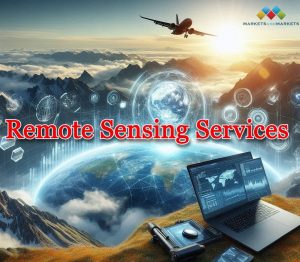The Global Remote Sensing Services Market Size is projected to grow from USD 13.2 billion in 2022 to USD 40.8 billion by 2030, at a compound annual growth rate (CAGR) of 14.9%. Remote sensing involves collecting data about target objects without direct contact, using electromagnetic radiation or acoustical waves. This market encompasses a range of applications, including technical training, data processing, and analysis for both commercial and defense purposes.

Download PDF Brochure @
https://www.marketsandmarkets.com/pdfdownloadNew.asp?id=87605355
Key Market Drivers
- Agricultural Efficiency: As the global population grows, efficient agricultural practices become increasingly critical. Remote sensing technologies like satellites and UAVs (Unmanned Aerial Vehicles) are crucial in precision agriculture, helping farmers monitor crop health, optimize resource use, and enhance yield. Satellite imagery provides day-to-day crop status analysis, identifying problematic regions and enabling better management of water and nutrients.
- Technological Advancements: Advances in satellite and UAV technologies have significantly improved the spatial, spectral, and temporal resolution of remote sensing data. This high-resolution data is essential for detailed environmental monitoring, topographic mapping, and distinguishing between different conditions of objects.
- Private Sector Investment: The growth of the private sector’s investment in satellite imagery and related technologies has fueled the expansion of remote sensing services. The use of satellite imagery for commercial applications, such as mineral exploration and environmental monitoring, has seen substantial growth.
Future Growth Prospects
The Remote Sensing Services market is set to expand across various segments:
- Agriculture: This application segment is expected to be the fastest-growing. The use of remote sensing in agriculture is vital for monitoring crop health, optimizing resource usage, and improving overall agricultural efficiency. This is particularly important given that 37% of the planet is used for agriculture.
- Satellites: The satellite platform segment holds the largest market share. Satellites provide critical data for a wide range of applications, from environmental monitoring to defense. High spatial, spectral, and temporal resolutions are key features driving the demand for satellite remote sensing services.
Technological Innovations
- AI and Data Integration: The integration of artificial intelligence with remote sensing data enhances the accuracy and reliability of the insights derived from the data. AI algorithms can process large datasets quickly, providing actionable insights for various applications.
- Advanced Imaging Technologies: Innovations in imaging technologies have improved the resolution and quality of data collected by remote sensing platforms. This is essential for applications that require detailed and precise information.
Regional Insights
- Asia Pacific: This region is expected to be the fastest-growing market for remote sensing services. Geospatial technologies are increasingly used for rural and agricultural development, city planning, and infrastructure projects. Countries in the Asia Pacific region are leveraging these technologies to enhance growth prospects and make strategic decisions.
Top Key Market Players
Key players in the Remote Sensing Services market include:
- Maxar Technologies (US)
- Planet Labs PBC (US)
- L3Harris Technologies (US)
- Airbus SE (Netherlands)
- Trimble, Inc. (US)
Ask for Sample Report @
https://www.marketsandmarkets.com/requestsampleNew.asp?id=87605355
The Remote Sensing Services market is poised for significant growth, driven by advancements in technology, increased investment from the private sector, and the critical need for efficient agricultural practices.
